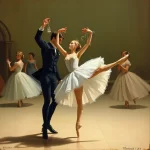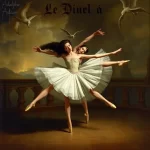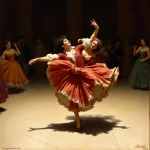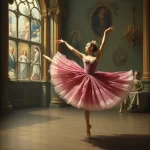Ballet: Cinderella (Baron Boris Fitinhof-Schell, 1893)

Introduction
Ballet has long been a cherished art form, blending music, dance, and storytelling into a seamless and captivating experience. One such ballet that has stood the test of time is “Cinderella,” composed by Baron Boris Fitinhof-Schell in 1893. This ballet, choreographed by Enrico Cecchetti, premiered on December 17, 1893, at the Mariinsky Theatre in St. Petersburg, Russia. The ballet tells the timeless story of Cinderella, a young woman who, despite her hardships, finds love and happiness with the help of a magical intervention.
Historical Background
Creation and Development
The late 19th century was a period of significant transformation in the world of ballet. The Romantic era had given way to a more classical approach, with an emphasis on technical precision and elaborate productions. It was within this context that Baron Boris Fitinhof-Schell composed “Cinderella.” The ballet drew inspiration from Charles Perrault’s 1697 fairy tale “Cendrillon,” which had already been adapted into various forms of art, including opera and theater.
Fitinhof-Schell collaborated closely with choreographer Enrico Cecchetti, a renowned ballet master known for his innovative techniques and teaching methods. Their partnership aimed to create a ballet that was both technically demanding and emotionally resonant. The production also involved contributions from set designers, costume designers, and other key figures who helped bring the magical world of Cinderella to life.
Premiere and Reception
“Cinderella” premiered on December 17, 1893, at the Mariinsky Theatre in St. Petersburg. The initial reception was overwhelmingly positive, with critics praising the ballet’s enchanting music, intricate choreography, and stunning visual elements. The audience was captivated by the story’s blend of romance, magic, and triumph over adversity.
Notable early performances included revivals in major European cities, where the ballet continued to garner acclaim. Over time, “Cinderella” became a staple in the repertoire of many ballet companies, solidifying its place in the history of classical ballet.
Synopsis of the Ballet
Act I Summary
The ballet opens with Cinderella living a life of servitude under the harsh rule of her stepmother and stepsisters. Despite her circumstances, Cinderella remains kind-hearted and hopeful. Her fairy godmother appears and, with the help of magical creatures, transforms Cinderella’s rags into a beautiful gown, complete with glass slippers. She is then whisked away to the royal ball.
Act II Summary
At the ball, Cinderella captures the attention of Prince Charming, who is immediately smitten by her grace and beauty. They share a romantic dance, but as the clock strikes midnight, Cinderella must flee, leaving behind one of her glass slippers. The Prince vows to find the mysterious woman who stole his heart.
Act III Summary
The Prince searches the kingdom, trying the glass slipper on every maiden he encounters. When he arrives at Cinderella’s home, her stepsisters attempt to fit into the slipper, but to no avail. Finally, Cinderella tries on the slipper, and it fits perfectly. The Prince recognizes her as his true love, and they are joyfully reunited.
Finale
The ballet concludes with a grand celebration of Cinderella and the Prince’s union. The couple’s happiness symbolizes the triumph of goodness and love over cruelty and hardship, leaving the audience with a sense of hope and enchantment.
Musical Composition
Composer’s Role
Baron Boris Fitinhof-Schell was a Russian composer known for his contributions to ballet and opera. His score for “Cinderella” is characterized by its lyrical melodies, rich orchestration, and ability to convey the story’s emotional depth. Notable pieces within the score include the “Waltz of the Flowers” and the “Midnight Chase,” which highlight Fitinhof-Schell’s talent for creating evocative and memorable music.
Musical Themes and Motifs
The score of “Cinderella” features recurring musical themes that enhance the narrative and emotional impact of the ballet. For example, Cinderella’s theme is gentle and wistful, reflecting her innocence and resilience. In contrast, the stepmother and stepsisters are accompanied by more discordant and harsh motifs, emphasizing their antagonistic roles. The music seamlessly transitions between these themes, guiding the audience through the story’s various moods and developments.
Famous Recordings and Performances
Over the years, several recordings of Fitinhof-Schell’s “Cinderella” have been made, capturing the beauty and complexity of the score. Notable performances include those by the Mariinsky Ballet and the Bolshoi Ballet, both of which have produced acclaimed interpretations of the ballet. These recordings and performances continue to introduce new audiences to the timeless charm of “Cinderella.”
Choreography and Dance
Choreographer’s Vision
Enrico Cecchetti’s choreography for “Cinderella” is a masterful blend of classical ballet technique and expressive storytelling. Cecchetti’s vision was to create a ballet that not only showcased the dancers’ technical prowess but also conveyed the emotional journey of the characters. His innovative use of mime and character dance added depth to the narrative, making the ballet accessible and engaging for audiences.
Signature Dance Numbers
Key dance numbers in “Cinderella” include the Pas de Deux between Cinderella and the Prince, which is a highlight of the ballet. This dance showcases the romantic connection between the two characters and features intricate lifts and turns that require exceptional skill and coordination. Another notable scene is the Fairy Godmother’s solo, where she performs a series of delicate and ethereal movements that underscore her magical nature.
Notable Interpretations
Over the years, various productions of “Cinderella” have offered unique interpretations of Cecchetti’s choreography. Some have emphasized the fairy tale’s whimsical elements, while others have focused on the darker aspects of Cinderella’s plight. These different approaches have kept the ballet fresh and relevant, allowing it to resonate with contemporary audiences.
Characters and Roles
Main Characters
- Cinderella: The protagonist, known for her kindness and resilience. Despite her hardships, she remains hopeful and ultimately finds happiness.
- Prince Charming: The royal heir who falls in love with Cinderella. He is determined to find her after she leaves the ball.
- Fairy Godmother: A magical figure who helps Cinderella attend the ball by transforming her appearance and providing her with glass slippers.
Supporting Characters
- Stepmother: Cinderella’s cruel and domineering stepmother who treats her poorly.
- Stepsisters: The stepmother’s daughters, who are vain and selfish. They also mistreat Cinderella.
- Royal Courtiers: Members of the Prince’s court who assist in the search for Cinderella.
Famous Dancers
Notable dancers who have portrayed these roles include Anna Pavlova as Cinderella and Vaslav Nijinsky as Prince Charming. Their performances have left a lasting impact on the ballet world, inspiring future generations of dancers.
Cultural and Artistic Impact
Influence on Ballet and Dance
“Cinderella” has had a significant influence on the world of ballet and dance. Its success paved the way for other fairy tale ballets, such as “The Sleeping Beauty” and “The Nutcracker.” The ballet’s emphasis on storytelling through dance has also inspired choreographers to explore new ways of blending narrative and movement.
Cultural Significance
The story of Cinderella has permeated popular culture, appearing in literature, film, and theater. The ballet’s adaptation of this timeless tale has contributed to its enduring appeal, making it a beloved story for audiences of all ages. Various adaptations, including Disney’s animated film and live-action versions, have kept the story relevant and accessible to new generations.
Legacy and Revivals
“Cinderella” continues to be performed and celebrated today, with major revivals by renowned ballet companies around the world. Modern adaptations often incorporate contemporary elements while staying true to the original story and choreography. These revivals ensure that “Cinderella” remains a vital part of the ballet repertoire.
Iconic Productions
Historic Productions
One of the most famous historical productions of “Cinderella” was staged by the Mariinsky Ballet in the early 20th century. This production featured elaborate sets and costumes designed by renowned artists, creating a visually stunning experience. Key figures involved included director Marius Petipa and set designer Alexandre Benois.
Contemporary Productions
Recent productions of “Cinderella” have introduced new interpretations and innovations. For example, Matthew Bourne’s contemporary version reimagines the story in a wartime setting, adding a unique twist to the classic tale. These modern adaptations highlight the ballet’s versatility and enduring relevance.
Production Design
The production design of “Cinderella” plays a crucial role in bringing the fairy tale to life. Set designs often feature grand ballrooms, enchanted forests, and magical transformations, while costumes range from Cinderella’s rags to her stunning ball gown. Lighting design enhances the mood and atmosphere, creating a magical and immersive experience for the audience.
Critical Reception and Reviews
Initial Critical Response
At the time of its premiere, “Cinderella” received glowing reviews from critics. They praised the ballet’s enchanting music, intricate choreography, and stunning visual elements. The combination of Fitinhof-Schell’s score and Cecchetti’s choreography was hailed as a triumph, solidifying the ballet’s place in the classical repertoire.
Modern Reviews
Contemporary critics continue to appreciate “Cinderella” for its timeless charm and emotional depth. Reviews often highlight the ballet’s ability to resonate with audiences of all ages, thanks to its universal themes of love, kindness, and perseverance. The ballet’s enduring popularity is a testament to its artistic and cultural significance.
Fun Facts and Trivia
Behind-the-Scenes Stories
One interesting anecdote from the original production involves the creation of Cinderella’s glass slippers. The costume designer experimented with various materials before settling on a transparent resin that mimicked the appearance of glass while being safe for the dancer to wear.
Notable Performers
Famous dancers who have portrayed roles in “Cinderella” include Margot Fonteyn, who brought grace and elegance to the role of Cinderella, and Rudolf Nureyev, whose portrayal of Prince Charming was both powerful and tender.
Trivia
- The original production of “Cinderella” featured over 200 costumes, each meticulously designed to reflect the characters’ personalities and roles.
- Fitinhof-Schell’s score includes a hidden musical motif that represents the ticking of the clock, adding a sense of urgency to the midnight scene.
- The ballet’s iconic glass slipper has been recreated in various materials over the years, including crystal, acrylic, and even LED-lit versions for modern productions.
Conclusion
Summary of the Ballet’s Importance
“Cinderella” remains a significant work in the world of ballet, thanks to its enchanting music, intricate choreography, and timeless story. The collaboration between Baron Boris Fitinhof-Schell and Enrico Cecchetti resulted in a ballet that continues to captivate audiences and inspire dancers worldwide.
Final Thoughts
Reflecting on the enduring appeal of “Cinderella,” it is clear that the ballet’s themes of love, kindness, and perseverance resonate with audiences of all ages. Whether experienced through a live performance or a recording, “Cinderella” offers a magical journey that reminds us of the power of hope and the triumph of good over evil. For those who have yet to experience this timeless ballet, it is a must-see that promises to enchant and inspire.
FAQ
What is the central theme of this ballet?
The central theme of “Cinderella” is the triumph of goodness and love over cruelty and hardship. The story emphasizes the importance of kindness, hope, and perseverance.
Who are the main characters in this ballet?
The main characters in “Cinderella” are Cinderella, Prince Charming, and the Fairy Godmother. Supporting characters include the Stepmother, Stepsisters, and Royal Courtiers.
What is the most famous dance number in this ballet?
The most famous dance number in “Cinderella” is the Pas de Deux between Cinderella and Prince Charming, which showcases their romantic connection and features intricate lifts and turns.
How long does a typical performance of this ballet last?
A typical performance of “Cinderella” lasts approximately two hours, including intermissions.
Are there any modern adaptations of this ballet?
Yes, there are several modern adaptations of “Cinderella,” including Matthew Bourne’s contemporary version set in a wartime context. These adaptations offer unique interpretations while staying true to the original story.
Why is this ballet considered important in the history of dance?
“Cinderella” is considered important in the history of dance because of its successful blend of music, choreography, and storytelling. It has influenced other fairy tale ballets and continues to be a beloved work in the classical ballet repertoire.





